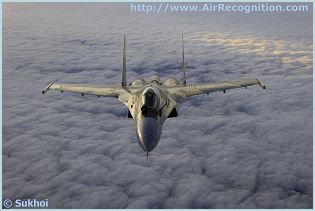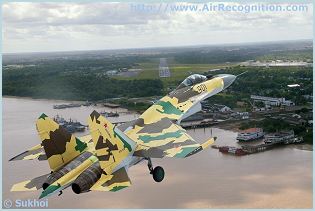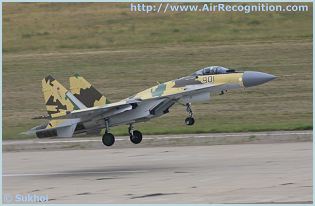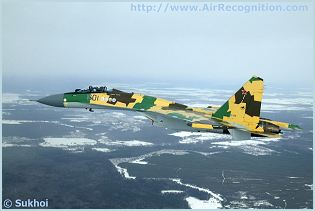Su-35 Flanker-E Sukhoi
| a | ||||||||||||||||||||||
|
Sukhoi SU-35 Multifunctional fighter aicraft
|
||||||||||||||||||||||
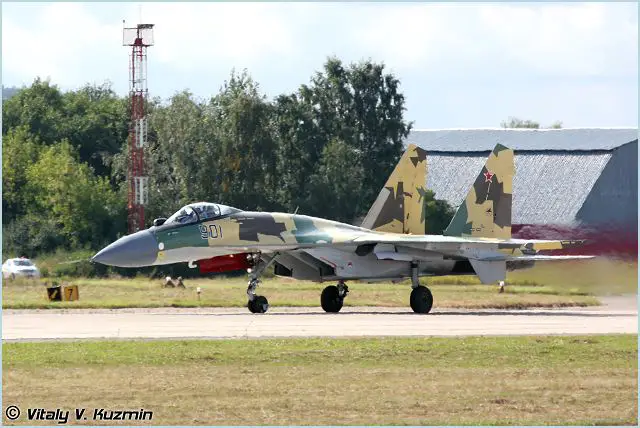 |
||||||||||||||||||||||
|
a
|
||||||||||||||||||||||
|
The Su-35 (NATO code name: Flanker-E) is a single-seat, twin-engined multifunctional fighter aicraft designed and manufactured by the Russian Aviation Industry Sukhoi. Intended to gain air superiority and engage aerial and ground targets when performing autonomous and group combat actions, by day and night, in VFR and IFR weather conditions. Its first flight took place on February 19, 2008. Following the first prototype, now on the assembly line of KnAAPO (Komsomolsk-on-Amur Aviation Production Association) are a further two examples of Su-35. On 18 August of the same year, the Russian Defense Ministry announced a contract for 48 Su-35S (Serial) fighters along with 16 Su-27/30 fighters to be delivered by 2015. On 14 October 2010, Sukhoi announced that the first production Su-35S had completed general assembly and that the first aircraft would be delivered to the Russian Ministry of Defense by the end of the year. In May 2011, the first production model Su-35S was flown for the first time. In 2009, Sukhoi estimated that the Su-35 would be manufactured at a rate of 24 to 30 aircraft each year from 2010 to 2020. In January, it was announced that the Su-35 wil enter into service with the Iranian Air Force in 2025. |
||||||||||||||||||||||
| Variants | ||||||||||||||||||||||
|
|
||||||||||||||||||||||
|
|
||||||||||||||||||||||
|
||||||||||||||||||||||
|
|
||||||||||||||||||||||
|
||||||||||||||||||||||
|
|
||||||||||||||||||||||
|
||||||||||||||||||||||
|
|
||||||||||||||||||||||
| Technical Data | ||||||||||||||||||||||
| Design | ||||||||||||||||||||||
|
The Su-35 is a radically modernized version of the Su-27 aircraft to significantly enhance its combat effectiveness against aerial, ground and sea tagets. For better agility and takeoff/landing performance, the aircraft is provided with a canard. In terms of its aerodynamic configuration, the Su-35 is an unstable triplane (wing + horizontal tail + canard). The Su-35 chassis has been reinforced because of the increased takeoff and landing weight of the aircraft. The required stability and controllability characteristics are assured through a quadruple-redundant digual-a.nalog remote control system. The Su-35 is equipped with a newly developed wing featuring an increased relative thickness. The main Handing gear struts are modified and the nose leg is replaced with ai reinforced two-wheel strut. The aircraft is equipped with an inflightt refueling system.
|
||||||||||||||||||||||
| Avionic | ||||||||||||||||||||||
|
The cockpit is equipped with a side aircraft control stick and engine control levers with a strain sensitive system responding to the pilot's hand pressure. The cockpit indication system is built around wide-scope color displays. The KD-36D-3.5E ejection seat back is inclined at 30 degrees, which helps the pilot withstand high g-loads during air combat.
The Su-35 is equipped with an integrated fire control and navigation system comprising: - a new-generation multifunction multimode phased-array radar able to detect and track up to 15 aerial targets and simultaneously engage four of them; - an optical locator, which combines functions of an infrared imager, a laser rangefinder and a target illuminator; - a helmet-mounted target designator; - ECM equipment; - an integrated data system; - communications facilities and flight control and navigation equipment; - an automatic flight control system. |
||||||||||||||||||||||
| Propulsion | ||||||||||||||||||||||
|
Another important difference of the Su-35 from predecessors from the Su-27 family is the use, in its power plant, of new engines with an increased thrust. Those engines, known as 117S, have been developed by NPO Saturn Research and Production Association. In terms of engineering, the engines are substantially modified AL-31F production engines employing fifth-generation technologies. They use a new fan, new high and low pressure turbines, and a new digital control system. A provision is made for using a vectored thrust nozzle. The modernization has increased the engine special mode thrust by 16%, up to 14,500 kgf. In the maximum burner-free mode it reaches 8,800 kgf. Compared to today’s AL-31F engines, their capabilities will grow substantially, by 2 to 2.7 times. For instance, the between-repair period will grow from 500 to 1,000 hours (the operating period before the first overhaul is 1,500 hours). The designed period will vary between 1,500 and 4,000 hours. The 117S engines will be co-produced by Ufa-based Motor Building Association and Rybinsk-based NPO Saturn Research and Production Association. The first production 117S engines were delivered to KnAAPO in early 2007 for testing on the first experimental Su-35 aircraft.
The AL-31FP engines featuring a high gasdynamic stability margin with a thrust vector control system integrated with the remote control system. This enable the pilot to fly maneuvers at low speeds down to near-zero values without angle-of-attack limitations. The aircraft is capable of flying the most advanced and unconventional flight maneuvers, such as «cobra», «hook», etc. |
||||||||||||||||||||||
| Armament | ||||||||||||||||||||||
|
The Su-35 weaponry is arranged at 12 hardpoints and comprises:
- RW-AE, R-27R1, R-27ER1. R-27T1, R-27ET1, and R-73E air-to-air missiles; - Kh-31A, Kh-31P, Kh-29L, Kh-29T, and Kh-59M air-to- surface missiles; - unguided and guided aerial bombs of various size and purpose. The aircraft is also equipped with the GSh-301 built-in gun with an ammunition load of 150 rounds. A great variety of its armament versions, sophisticated equipment and high performance characteristics allow the Su-35 to fly the most diverse tactical missions. The core of the Su-35 armament is a new radar control system with a phased antenna array (Irbis-E). It features unique capabilities in terms of the target detection range. This is a development V V Tikhomirov Research Institute of Instrument Production. In design, this is an X-waveband multi-role radar with a passive phased antenna array (PAA) mounted on a two-step hydraulic drive unit (in azimuth and roll). The antenna device scans by an electronically controlled beam in azimuth and angle of elevation in sectors not smaller than 60°. The two-step electro-hydraulic drive unit additionally turns the antenna by mechanic means to 60° in azimuth and 120° in roll. Thus, in using the electronic control and mechanical additional turn of the antenna, the maximum deflection angle of the beam grows to 120°. Irbis-E radar control system detects and tracks up to 30 air targets, retaining continuity of space observation and engaging up to eight targets. The system detects, chooses and tracks up to four ground targets in several map-making modes with various resolution at a range of up to 400 km, without stopping to monitor the airspace. Irbis-E radar detects air targets with an absolute cross section of 3 m2 on a head-on course at a range of up to 400 km. |
||||||||||||||||||||||
| Specifications | ||||||||||||||||||||||
|
||||||||||||||||||||||
 |
||||||||||||||||||||||
|
||||||||||||||||||||||






























